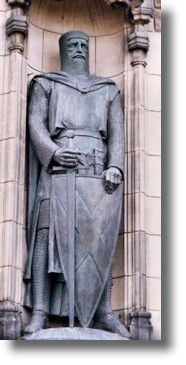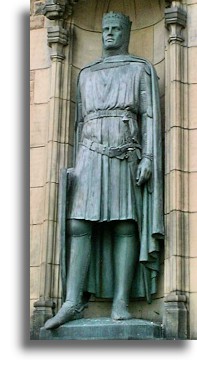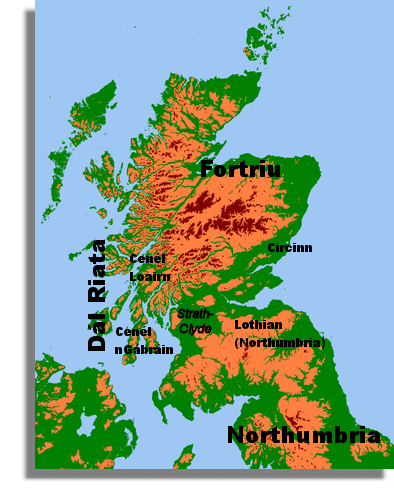

Scots History to 1400
By Michael Lynch
This is a section from the book "Scotland: a New History" by Michael Lynch which covers Scottish history from the earliest times to the present. There is an Index page of all the sections of the book up to the end of the 14th century which have been added to Rampant Scotland. The pages were previously part of the "Scottish Radiance" Web site.
Consolidation of the Kingdom of Fortriu (Northern Pictland) and the 'smiting of Dalriada' in 741

Chequered History of Dalriadic Kings
Why did the Cenél Loairn suddenly emerge in the later seventh century as a more potent force in Dalriada (also known as Dál Riata) and slip back less than a hundred years later? The route to power in early Scotland, as with many barbarian peoples elsewhere, is rarely to be found in the conventional working terms of medieval or early early modern historians: consolidation, expansion, hegemony. The Cenél Loairn do not seem to have succeeded to the overkingship of Dalriada as a result of a greater consolidation of their power within their own heartland. On the contrary the Senchus shows that Cenél Loairn, spread out over the rugged country of northern Argyll, had only the same total fighting strength as the tighter-knit Cenél nÓengusa based on Islay. The picture of the dynasty of Cenél Loairn in the early eighth century, under attack on three fronts, was typical of early kingship, in Dalriada and elsewhere in northern Britain. There were also internal feuds, which resulted in Selbach, King of Dalriada, having to lay waste to Dunollie, a stronghold of Cenél Loairn septs, in 701. The overkingship was disputed by the Cenél nGabráin, who briefly gained the upper hand after a naval victory over Selbach waters somewhere in Dalriadic waters in 719; it was the first recorded sea battle in the history of Britain. Most seriously of all, they faced the brunt of a sustained period of aggression waged by Óengus, King of Picts, which culminated in the 'smiting of Dalriada' in 741. The result, it is likely, was the eclipse of Cenél Loairn ambitions. Yet it would be another segment of this divided royal house which; barely a century later, would capture control of Pictland in the person of Kenneth mac Alpin. The chequered history of Dalriadic kings suggests some need for refinement of the historian's conventional tools used to describe the mechanics of displacement of one ruling house by another.
The Consolidation of the Kingdom of Fortriu
The locus of power in the Pictish kingdom is hard to locate Not surprisingly, in a confederation of tribes that was looser and covered a far greater areas than the Scots of Dalriada, power shifted both at the level of the many túatha and in the location of the overking. Separated amongst themselves by the barrier of the Mounth, it is likely that there may long have been two overkings, corresponding to the two sets of Pictish peoples, north and south of it. Yet there are also hints from the sixth century or even before that one was senior. Where might he have located? In the fourth century, the seat of Pictish power seems to have lain in Strathearn and Menteith; the survey in the De Situ Albanie gave premier place to Circenn, in Angus and the Mearns, but at an undisclosed date; by the late sixth century, when Columba visited King Bridei at his court near Inverness, the focus of Pictish powers seems to have lain in the north. Bridei was certainly overlord of the Pictish people to the north of the Mounth, but it may be that the notion of high kingship can be traced to this period.
A hundred years later in 685, when Bridei mac Bile defeated Northumbrian invaders at Dunnichen Moss (also known as the Battle of Nechtansmere) in Angus, there is no doubt that he is acknowledged as high king of all the Picts. The graphic here is from the Aberlemno Pictish stone. It is generally presumed to show the Battle of Dun Nechtain, Picts on the left, Northumbrians on the right, the mounted Pictish figure perhaps representing King Bridei. the centre of Pictish royal power had moved decisively southwards, to Fortriu, where it would remain.
Viewed in retrospect, the growth of the kingdom of Fortriu conveniently summarises the development of Pictish kingship. Kings of Fortriu were probably originally tribal rí, whose power was limited to Strathearn; by the second half of the seventh century, it is likely that they were also acknowledged as overkings of the Picts south of the Mounth. Half a century later they were also high kings of all the Picts. The nomenclature is confusing if the three different grades of kings and the three different usages of the phrase 'King of Fortriu' are not borne in mind. The position, however, was clear to contemporary chroniclers, whether Irish or Northumbrian. Bede certainly viewed Pictland as a single political entity in his own day, in the early eighth century; he describes the kingdom of Nechtan in 710 as embracing all the provinces of the Picts. And the writers of Irish Annals often use the name of Fortriu as synonymous with the Pictish nation as a whole from the reign of Bridei (d. 693) onwards.
It is not surprising that it was shortly after this, during the long reign of Nechtan between 706 and 724, that the genealogists probably got to work on Pictish king lists and polished the origin legends of their royal patron. The contrast of Dalriada and Pictland is informative: Dalriadic kings were middle-ranking kings of an increasingly fissiparous set of peoples located within a small but difficult territory. Pictish kings would come to be described as reges Pictorum, high kings of a far-flung collection of peoples; their new-found status was all the more notable in such a widespread territory. The achievement of the kings of Fortriu in the eighth and ninth centuries was one of the most notable in Scottish history, but its nature is easily mistaken if overlaid with the conventional vocabulary of later, medieval kingship. their success was not to consolidate but to confederate.
Return to Index of Scots History to 1400



